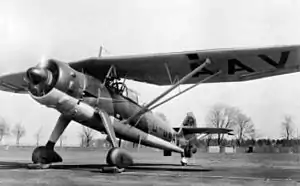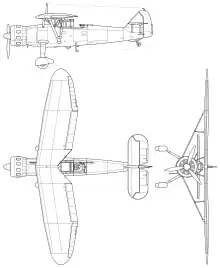Henschel Hs 126
The Henschel Hs 126 was a German two-seat reconnaissance and observation aircraft of World War II that was derived from the Henschel Hs 122. The pilot was seated in a protected cockpit under the parasol wing and the gunner in an open rear cockpit. The prototype aircraft frame was that of a Hs 122A fitted with a Junkers engine. The Hs 126 was well received for its good short takeoff and low-speed characteristics which were needed at the time. It was put into service for a few years, but was soon superseded by the general-purpose, STOL Fieseler Fi 156 Storch and the medium-range Focke-Wulf Fw 189 "flying eye".
| Hs 126 | |
|---|---|
 | |
| Role | Reconnaissance |
| National origin | Nazi Germany |
| Manufacturer | Henschel, AGO |
| First flight | August 1936 |
| Introduction | 1937 |
| Retired | 1943 |
| Status | Retired |
| Primary users | Luftwaffe |
| Produced | 1937–1941 |
Development
The first prototype was not entirely up to Luftwaffe standards; it was followed by two more development planes equipped with different engines. Following the third prototype, ten pre-production planes were built in 1937. The Hs 126 entered service in 1938 after operational evaluation with the Legion Condor contingent to the Spanish Civil War.
Operational history
By the time the Hs 126 A-1 joined the Luftwaffe, the re-equipping of reconnaissance formations was already well advanced. By the start of World War II in September 1939, the Hs 126 served with Aufkl.Gr 10, 11, 12, 13, 14, 21, 23, 31, 32 und 41. They were used with great success in the attack on Poland where it proved itself as a reliable observation and liaison aircraft. Its use continued after the end of the Phony War in May 1940. It suffered some losses when intercepted by Allied fighter aircraft: 20 Hs 126s were lost between 10 and 21 May 1940.
Its successor, the Focke-Wulf Fw 189 entered service in 1940 but the Hs 126 remained the main short range reconnaissance aircraft until 1942. 47 squadrons equipped with Hs 126s participated in the invasion of the Soviet Union in 1941. The Hs 126 was also used in North Africa, such as with the 2./Aufklärungsgruppe (H)/14 which used the type until the end of 1942.
Late in the war, it was used in glider tug and night ground attack roles, but production of the Hs 126 ended in 1941 and the type was retired from the front line in 1943.[1]
On 12 September 1943 Henschel 126s were used to tow 10 DFS 230 attack gliders from Pratica Di Mare airfield near Rome to the Gran Sasso on a raid to rescue Benito Mussolini. Mussolini had been imprisoned there after being deposed by the Grand Council of Fascism, followed by a decree from the King of Italy. The Henschel was a smaller tow plane compared the usual Junkers Ju 52 three-engine tow plane and struggled to gain altitude to clear the mountains on the way. This led to confusion when the lead Kette of three gliders turned to gain altitude allowing Otto Skorzeny's group of three gliders to assume the lead.[2]
Greece
At the outbreak of Greco-Italian War of 1940–41, the Royal Hellenic Air Force (Ellinikí Vasilikí Aeroporía, RHAF) had in service 16 Henschels, with 3 Observation Mira, under III Corps, based in Thessaloniki and Veria. Two days after the start of the war, on 30 October, there was the first air battle between Italian Regia Aeronautica and the RHAF when some Henschel Hs 126 of 3/2 Flight from 3 Observation Mira took off to locate Italian Army columns. But they were intercepted and attacked by Fiat CR.42s of 393a Squadriglia. A first Henschel was hit and crashed, killing its observer, Pilot Officer Evanghelos Giannaris, the first Greek aviator to die in the war. A second Hs 126 was downed over Mount Smolikas, killing Pilot Officer Lazaros Papamichail and Sergeant Constantine Yemenetzis.[3]
Operators
Specifications (Hs 126 B-1)

General characteristics
- Crew: Two (pilot and observer/gunner)
- Length: 10.9 m (35 ft 7 in)
- Wingspan: 14.5 m (47 ft 7 in)
- Height: 3.8 m (12 ft 4 in)
- Wing area: 31.6 m2 (340 ft2)
- Empty weight: 2,030 kg (4,480 lb)
- Loaded weight: 3,090 kg (6,820 lb)
- Powerplant: 1× Bramo 323 9-cylinder radial engine, 625 kW (838 hp) (850 PS)
Performance
- Maximum speed: 356 km/h at 3,000 m (221 mph at 9,850 ft)
- Range: 998 km (620 mi)
- Service ceiling: 8,530 m (28,000 ft)
- Rate of climb: 550 m/min (1,800 ft/min)
- Wing loading: 97.8 kg/m2 (20.1 lb/ft2)
- Power/mass: 0.21 kW/kg (0.13 hp/lb)
Armament
- 1 × forward-firing 7.92 mm (.312 in) MG 17 machine gun
- 1 × flexible 7.92 mm (.312 in) MG 15 machine gun in the observer/gunner
- Up to 150 kg (330 lb) of bombs
See also
Aircraft of comparable role, configuration, and era
- ANF Les Mureaux 113
- LWS-3 Mewa
- Westland Lysander
- Levente II
- Mitsubishi Ki-15
- Stinson L-1 Vigilant
- Stinson L-5 Sentinel
- Polikarpov Po-2
- Aeronca L-3 Grasshopper
Related lists
References
Notes
- Simkin, John. "Henschel Hs 126B." Archived 2012-12-03 at the Wayback Machine Spartacus Educational. Retrieved: 12 September 2012.
- Raid: Rescuing Mussolini, Robert Forczyk- Osprey Publishing, April 2010; 64 pages; ISBN 9781846034626
- Carr 2012, p. 4-17
Bibliography
- Carr, John, On Spartan Wings, Barnsley, SY: Pens & Sword Military, 2012. ISBN 978-1-84884-798-9.
- Gerdessen, Frederik. "Estonian Air Power 1918 – 1945". Air Enthusiast, No. 18, April – July 1982. pp. 61–76. ISSN 0143-5450.
- Gerdessen, F. Versatile Informer in Estonia. Air Enthusiast 105, May/June 2003, p. 76. ISSN 0143-5450
- Green, William. Warplanes of the Third Reich. London: Macdonald and Jane's Publishers, 1970 (fourth impression 1979). ISBN 0-356-02382-6.
- Lapierre, P. & Taghon, P. (June 2000). "Henschel 126 "contre" l'Angleterre" [Henschel 126 Against Britain]. Avions: Toute l'Aéronautique et son histoire (in French) (87): 26–35. ISSN 1243-8650.
- Luranc, Zbigniew. Henschel Hs 126 - Skrzydła w Miniaturze (in Polish). Gdańsk, Poland: Wydawnictwo Avia-Press, 1995. ISBN 83-902964-0-3.
- Nowarra, Heinz J. Nahaufklärer, 1910-1945: Die Augen des Heeres (in German). Stuttgart, Germany: Motorbuch Verlag, 1981. ISBN 3-87943-808-0.
- Pęczkowski, Robert and Robert Panek. Henschel Hs 126. Sandomierz, Poland/Redbourn, UK: Mushroom Model Publications, 2008. ISBN 83-89450-40-2.
- Smith, J. Richard and Anthony Kay. German Aircraft of the Second World War. London: Putnam & Company, 1972 (third impression 1978). ISBN 0-370-00024-2.
- Wood, Tony and Bill Gunston. Hitler's Luftwaffe: A Pictorial History and Technical Encyclopedia of Hitler's Air Power in World War II. London: Salamander Books Ltd., 1977. ISBN 0-86101-005-1.